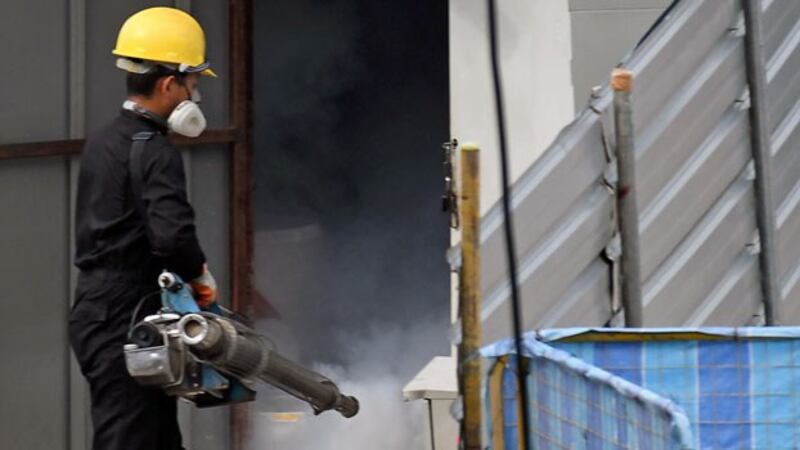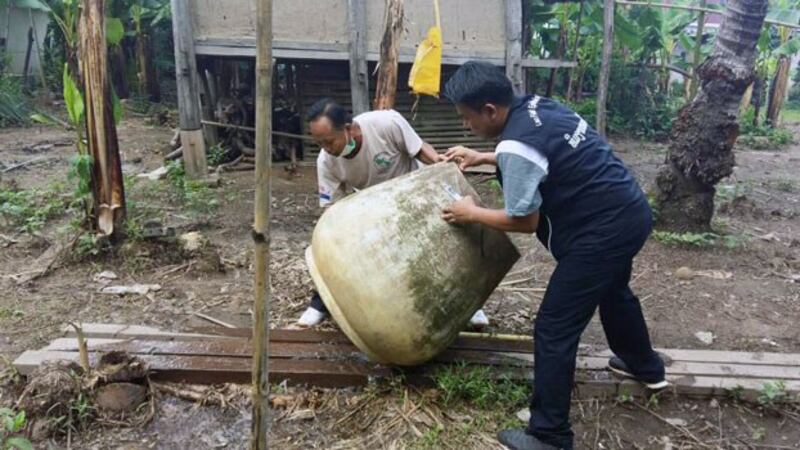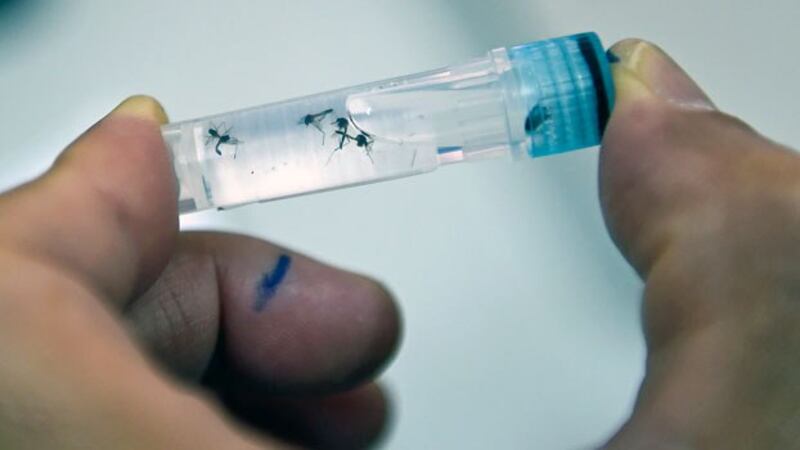The COVID-19 crisis has complicated efforts to combat the seasonal spike in dengue fever infections during the Southeast Asian monsoon season due to the burden the coronavirus pandemic has placed on health authorities in the region, experts say.
Dengue is carried by mosquitoes and is one of the world’s most dangerous and fastest spreading viral diseases. While infections have decreased significantly from the sharp rise experienced in 2019, residents in one of the worst-hit nations, Laos, complain that authorities are not doing enough to prevent it during the current rainy season.
“I am afraid of it — afraid because there are no preventive measures,” said a resident of Bolikhamxay province, which has the second-highest number of infections in Laos after the capital Vientiane. The man declined to give his name for fear of angering authorities.
The prevention of dengue depends upon effective and sustained control measures. These include spraying insecticides in and around homes and emptying stagnant water from tree holes, old tires, and discarded containers, so they don't become breeding grounds for mosquitoes.
But experts say that poor public health infrastructure in many low- and middle-income countries in Southeast Asian countries has been stretched to its limits this year, as medical professionals focus on treating patients with the COVID-19 respiratory virus.
“Unfortunately, COVID-19 has impacted a range of routine health-related programs in many countries,” said Dr. Raman Velayudhan of the World Health Organization’s Department of Control of Neglected Tropical Diseases in Geneva, Switzerland.
“Maintaining the delivery of essential health services and preventive measures, including vector control programs, has been challenging for some countries,” he said.

Higher risk in urban areas
Experts cite rapid urbanization, high-density settlements, and climate change for an overall surge in dengue since the beginning of the century. According to the WHO, dengue has become one of the fastest emerging and spreading viral infections in Southeast Asia with high incidences in recent years in Laos, Thailand, Singapore, and the Philippines.
Unlike malaria which spreads mostly in rural areas, dengue is more of a problem in towns and cities. It is transmitted to humans through bites by female Aedes aegypti mosquitoes in subtropical and tropical regions, especially during a critical period from July to November.
Typical symptoms include fever, headache, nausea, muscle and joint pains, and a skin rash. But with four dengue virus strains, it is possible for people to be infected subsequent times, increasing the risk of developing severe dengue, a potentially fatal complication.
This year, government-mandated lockdowns to prevent the spread of COVID-19 may have increased the risk of dengue infections in some urban areas where both viral infections are prevalent, experts said.
"Mandated lockdowns mean people are spending more time in the home, where most transmissions of dengue from Aedes aegypti mosquitoes occur," said Scott O'Neill, director of the World Mosquito Program, in a printed statement.
“Many dengue control measures — such as removal of potential mosquito breeding sites by local residents — have also ceased,” he said. “Health workers who usually promote this work in the community are working from home or many have been reassigned to their local COVID-19 response.”
Another complicating factor is that medical professionals may have difficulty distinguishing between COVID-19 and dengue, which both have similar clinical and laboratory features in their early stages.
“Where the impact has probably been greatest has been in the differential diagnosis and in treating dengue patients, mainly because the focus has been on COVID-19,” said Duane Gubler, a dengue expert at the Duke-NUS Medical School in Singapore. “Most fevers are being diagnosed and managed as COVID-19.”

Where are the authorities?
Laos registered a cumulative 4,155 reported dengue cases as of Aug. 9 in line with seasonally expected levels, according to the WHO. Among the cases were nine deaths, including the most recent fatality in Vientiane prefecture’s Hadxayfong district.
“We haven’t seen them [authorities] come to spray to kill the dengue mosquito carriers,” said a Vientiane resident, who declined to give his name while criticizing authorities.
The man said he and his neighbors must continually empty rainwater from outdoor containers where it collects to prevent mosquitoes from laying eggs and to destroy their larvae.
“If the officials come down to spray in all the places where it’s needed, then the prevention of the disease would have more effective results,” he said.
An official from the Lao Ministry of Health, who declined to give his name because he is not authorized to speak to the media, said that the government has notified provincial authorities to enact prevention plans.
“Our ministry sent out notices to the provinces, and the provinces then sent them out to the districts, so that districts can carry out prevention plans to get rid of items that collect water around homes and to clean up their surroundings,” he told RFA’s Lao Service.
Dale Amtsberg, communications director at the nonprofit World Mosquito Program, said that there is a multiyear cycle with dengue fever, “so there are years with high numbers of cases and years with fewer cases.”

Case numbers down
The year 2019 was a particularly bad one in a number of Southeast Asian nations, and 2020 is looking better, with a sharp decrease in reported dengue infections so far in those countries.
The number of cases reported in Laos this year is 5.5 times lower compared to the same period in 2019 when 22,737 cases were reported, according to WHO figures.
In neighboring Vietnam, the total cumulative number of dengue cases this year as of Aug. 2, was 48,484 with three deaths — a 64.1 percent decrease on the same period in 2019.
As of July 19, Cambodia has registered 4,450 dengue cases with five deaths — about one-tenth of the cases reported during the same period in 2019. Myanmar also has seen a fall.
But prosperous Singapore has gone in the opposite direction. As of Aug. 16, it reported more than 25,000 dengue cases with about 20 deaths, compared with 16,000 cases in all of 2019, according to the country’s National Environment Agency.
The number of cases spiked in 2019 because it was an El Niño year that contributed to changed weather patterns in South and Southeast Asia, Dr. Velayudhan said.
“Traditionally monsoonal seasons over a shorter period were replaced in some places with showers scattered over several months, creating multiple opportunities for mosquito breeding and prolonging the survival of mosquitoes as opposed to their lifespan in a short monsoon season,” he said.
One pharmacist’s prescription
Dealing with dengue effectively when it strikes depends on quick action, experts say. Although there is no specific treatment for dengue or its potentially fatal severe form, early detection and access to proper medical care lowers fatality rates of severe dengue to below 1 percent, according to the WHO.
The problem is many people do not seek medical help when they contract dengue. In places like Laos, where the health care is usually poor, those with dengue infections often forego a trip to a district or provincial hospital, instead preferring to buy medicine locally to take at home.
A pharmacy owner in the country’s northwestern Xayaburi province, which has reported a significant number of dengue fever cases this year, including one death, says locals often come to him for medicine to treat dengue.
“If they do not want to go to the hospital, I will sell them a bag of intravenous fluid together with paracetamol if they are not yet in a serious condition,” he said, referring to acetaminophen tablets that relieve and reduce fever. The saline infusion he gives them helps dengue fever sufferers maintain enough water in their body, he said.
Meanwhile, experts are urging authorities this year to sustain spraying with insecticides both outdoors and indoors to kill mosquitoes, so dengue doesn’t present an even bigger drain on health care systems already creaking because of the COVID-19 pandemic.
Bridget Wills, a dengue expert associated with the Oxford University Clinical Research Unit in Ho Chi Minh City, Vietnam, said these control methods are labor intensive, but “you have to keep doing them.”
Additional reporting by RFA’s Lao Service. Translated by Manichanh Phimphachanh.
